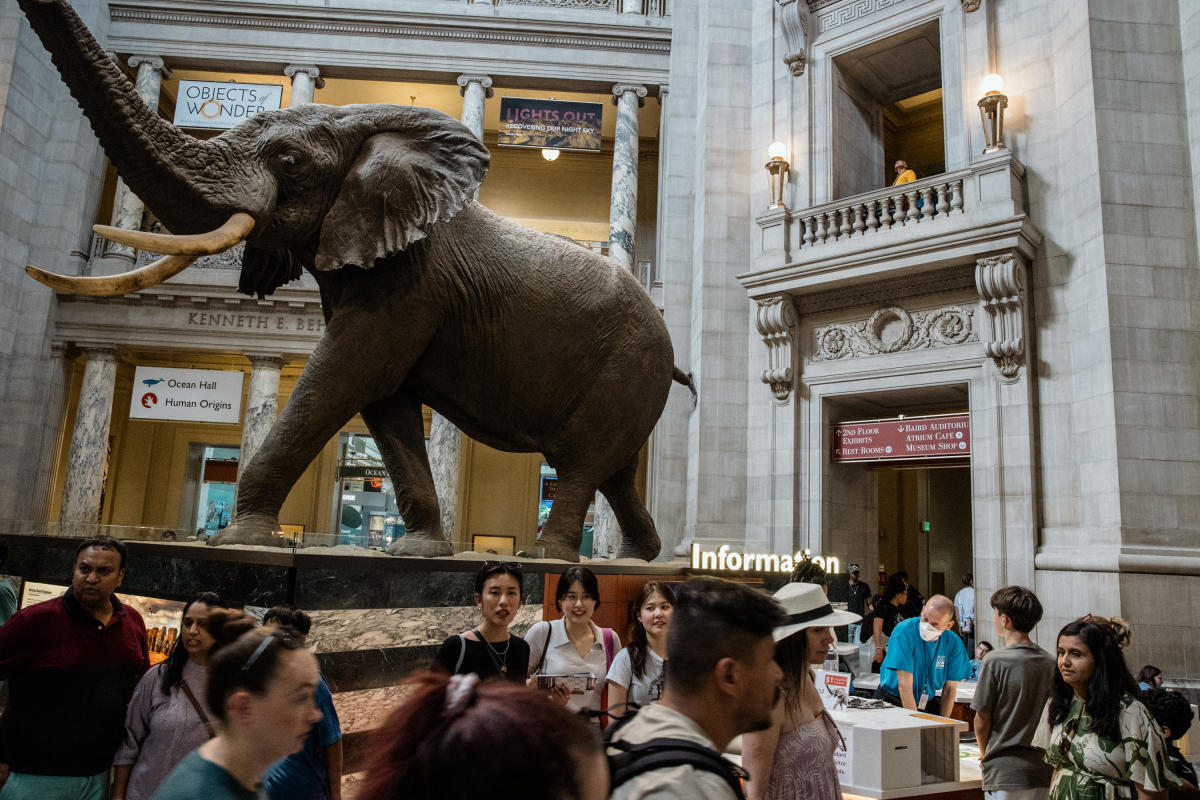By now, it’s as familiar as sunscreen hitting the shelves: Americans are headed into another summer with new coronavirus variants and a likely uptick in cases.
This is shaping up to be the first covid wave with barely any federal pressure to limit transmission and little data to even declare a surge. People are no longer advised to isolate for five days after testing positive. Free tests are hard to come by. Soon, uninsured people will no longer be able to get coronavirus vaccines free.
“If a wave materializes this summer, we’re less poised to navigate the rough waters,” said Ziyad Al-Aly, an epidemiologist and long-covid researcher at the Veterans Affairs health-care system in St. Louis.
So we’re left with a virus that continues to hum in the background as an ever-present pathogen and sporadic killer. The public health establishment no longer treats covid as a top priority. Only a smattering of passengers still wear masks on trains and planes. Weddings, vacations and conferences carry on as normal. Many who do get sick won’t ever know it’s covid. Or care.
Covid returned to the headlines following the rise of new variants dubbed “FLiRT,” far catchier than the JN.1 variant that drove the winter wave. Leading the pack of those variants in the United States is KP.2, accounting for 28 percent of all infections as of early May, according to the Centers for Disease Control and Prevention. But public interest seems driven more by the name than the biological features of the variants, which appear unremarkable beyond the expected evolution of a virus to infect people more easily.
Summer offers a reminder of why covid is unlike the flu, a more predictable fall and winter respiratory virus. Coronavirus ebbs and flows throughout the year, and hospitalizations have always risen in summer months when people travel more and hot weather drives people indoors. For now, covid activity is low nationally, the CDC said Friday. The number of Americans dying of covid is less than half what it was a year ago, with a death toll around 2,000 in April. The virus poses a graver threat to the severely immunocompromised and elderly. But it can still surprise younger healthy people, for whom a bout of covid can range from negligible sniffles to rarer long-term debilitating effects.
When Lauren Smith, a 46-year-old triathlete in New Jersey, got covid in late April, she figured it would be a “nothingburger” like her first case two summers ago. Instead, she said she developed persistent fatigue for weeks that has made it difficult to train, and she decided to pull out of her upcoming competition. Her case is one that doctors would call mild, but Smith says doing so obscures the reality of a virus more complicated than the flu.
“There’s no care or attention given to the fact that this is serious,” said Smith, noting that she was one of the only masked attendees at a recent Guster concert in Philadelphia. “I feel like so many people have said, ‘I’m tired of this, I don’t want to deal with this anymore.’ And I don’t feel like the CDC or any other agency is doing anything to combat that.”
The Biden administration and the CDC don’t talk much about covid anymore, save for sporadic updates on data and variant tracking, and the president’s criticism, when campaigning, of his predecessor’s handling of covid. CDC Director Mandy Cohen hasn’t tweeted about covid since March. The agency declined to make an official available for an interview about its response.
The CDC and health authorities continue to promote the coronavirus vaccine, last updated in fall 2023 for a subvariant no longer in circulation, as the best form of protection against the disease. Just 23 percent of adults have received a dose of the latest vaccine, the CDC estimates. Experts say the existing formula should still confer protection against severe illness from the FLiRT variants. People 65 and older qualify for a second dose, but only 7 percent have received two shots.
Expert advisers to the Food and Drug Administration are scheduled in June to recommend the composition of the coronavirus vaccine to be released in the fall to protect against the latest variants.
But people without health insurance will no longer qualify for free vaccines under the CDC’s Bridge Access Program, which ends in August after providing more than 1.4 million free shots. Funding for the program ran out, and efforts to establish a broader national program offering free vaccines for adults have languished.
Peter Hotez, co-director of the Texas Children’s Hospital Center for Vaccine Development, said declining covid data collection will make it harder to persuade Americans that the virus poses enough of a threat to merit getting vaccinated.
In April, hospitals stopped reporting confirmed covid-19 cases – ending the most commonly cited metric for measuring the virus’s toll. The CDC still tracks the levels of coronavirus detected in wastewater and discloses the percentage of emergency room visits with a diagnosed covid-19 case, which has been declining since February. But Hotez said the available metrics are no longer enough to properly grasp the covid situation.
“We’re kind of shooting blind now,” said Hotez, who is also dean of the National School of Tropical Medicine at Baylor College of Medicine.
Public health officials treat covid with less urgency in part because hospitals no longer report that covid patients pose a significant threat to their capacity.
Raynard Washington, who leads the Mecklenburg County health department in North Carolina, noted that while covid remains deadlier and more transmissible than the flu, the virus has become far more manageable because of vaccination.
“It’s not causing disruption to our everyday life like it used to,” Washington said.
While health-care systems can manage covid waves, Otto Yang, associate chief of infectious diseases at UCLA’s David Geffen School of Medicine, said the immunocompromised and older adults at high risk of developing severe disease are often overlooked.
“Those people unfortunately carry a heavy burden,” Yang said. “I’m not sure there is a good solution for them, but one thing could be better preventive measures.”
The covid protection measures that were a staple of earlier summers – requests to test before attending weddings, mask requirements at conferences, outdoor locations for celebrations – are falling by the wayside.
Many summer campers, for instance, will no longer be forced to isolate for covid while asymptomatic since the CDC revised its quarantine protocols to allow people to reemerge after their fevers break, said Tom Rosenberg, president and chief executive of the American Camp Association. But other covid protections have stuck: Opening windows to improve ventilation, screening for symptoms of illness and discouraging parents from helping their kids unpack when they arrive. Regardless of the pandemic’s severity, Rosenberg said, camps seek to minimize disruptions from illness.
“Kids can have more fun,” Rosenberg said. “We want to keep them in camp as much as we can as long as they are well and ready to participate.”
Others trying to keep precautions in place face greater challenges as they become outliers.
Organizers of Dyke Fest, an LGBTQ+ community gathering in D.C., wanted to be inclusive of immunocompromised people when they asked attendees to wear masks and test before coming to a bar where more than 250 attendees drank, browsed jewelry and art, and joined packed crowds watching drag performances. But compliance was spotty and enforcement tricky when rain drove people indoors, where drinking and masking don’t easily mix, and pandemic masking norms have eroded.
“Culturally we are coming away from it as a society, so it gets much harder to ask people to really be consistent, because they aren’t doing it anywhere else,” said D Schwartz, one of the organizers. “You go into a movie theater now, you see maybe five people wearing a mask.”
Medically vulnerable people are adjusting to a world where they can’t count on people to mask anymore, even at the doctor’s office. In North Carolina, Republican lawmakers proposed legislation in May that would criminalize mask-wearing in public, even for medical reasons, in response to growing protests against the war in Gaza, where many protesters have worn medical masks.
The proposal floored Cat Williams, who received a double lung transplant and faces heightened danger from covid infections because she takes medication that suppresses her immune system. At medical appointments, she has had to plead with medical staff to cover their faces while she gets her blood drawn and undergoes X-rays. The prospect of getting arrested for wearing a mask and being forced to take it off in a crowded jail makes her even more fearful to leave home. And she worries mask skeptics will be emboldened to harass people who wear them.
“We have a target on our backs,” said Williams, 53, of Charlotte. “They don’t want anyone to give them the reminder that covid is around.”
– – –
Clara Ence Morse contributed to this report.
—
Video Embed Code
Video: People are no longer advised to isolate for five days after testing positive. Hospitals stopped reporting confirmed covid-19 cases. Here’s what you need to know about covid this summer.(c) 2024 , The Washington Post
Embed code:
This embedded content is not available in your region.
Related Content
Fentanyl is fueling a record number of youth drug deaths
In a place with a history of hate, an unlikely fight against GOP extremism
Life in Taiwan is rowdy and proud, never mind China’s threats

Rachel Carter is a health and wellness expert dedicated to helping readers lead healthier lives. With a background in nutrition, she offers evidence-based advice on fitness, nutrition, and mental well-being.








